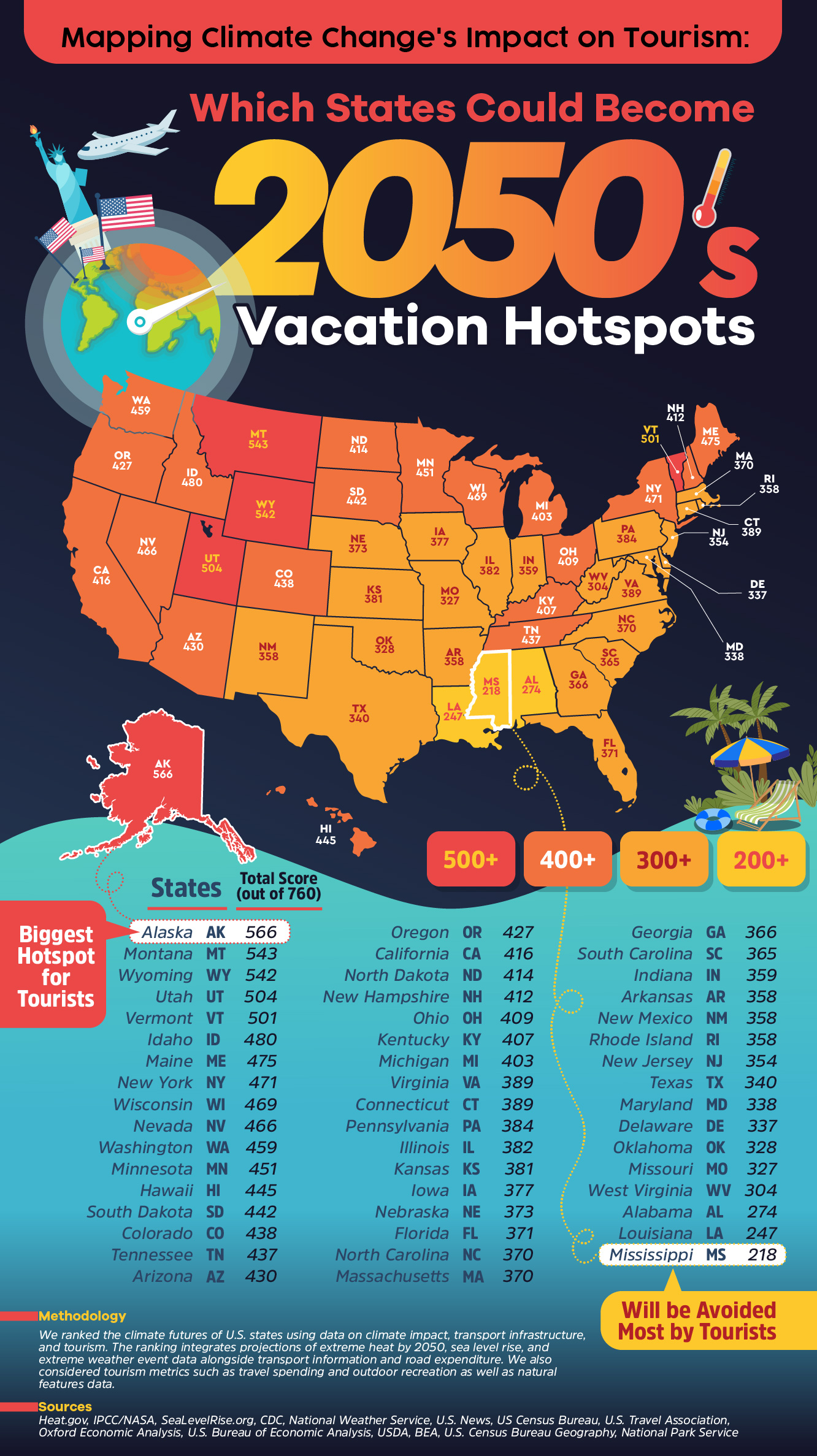Goodbye Florida, Hello Montana? The Future of Vacation in a Warming World
 The Future of Vacation
The Future of Vacation
Who doesn’t love a vacation full of fun in the sun? Probably more people than you think, thanks to global warming. Florida, Southern California, and coastal Texas have been staple vacation destinations for decades, but climate change and global warming might change that sooner than you think. But how soon is “soon?”
We dove deep to figure out how the rising temperatures and sea levels will change what the go-to vacation spots are around the country. And the results might surprise you…
Putting the “Hot” in Hotspot
If you’ve ever been to Florida in July or August, you know just how uncomfortable the state’s patented combination of heat and humidity can be. Yeah…not ideal. So with temperatures rising, northern states like Alaska and Montana are likely going to be tourist hotspots come 2050.

Florida is the vacation destination of the U.S. right now, but it might not be for long. By 2050, the National Integrated Heat Health Information System (NIHHIS) predicts that almost every district in Florida will experience more than 35 “extreme heat days” per year. Their definition of an extreme heat day is one where the temperature is in the top 1% of historic values.
We don’t know about you, but waiting in line at Disney World in historically hot weather isn’t something we’d be clamoring to do.
The situation is much the same throughout other southern summer vacation destinations. Southern California, Texas, and Louisiana are all projected to have more than 150 days over 90 degrees Fahrenheit by 2050, again according to NIHHIS data. In case that’s not sinking in, that’s HALF the year at over 90 degrees.
So, where else will travelers be heading to beat the heat on vacation? The following states are likely to be the most touristy in 2050 thanks largely to rising temperatures and the related ill-effects. These also have some stellar nature and tourist attractions, as well.
The NEW Most Touristy States in 2050
- Alaska
- Montana
- Wyoming
- Utah
- Vermont
- Idaho
- Maine
- New York
- Wisconsin
- Nevada
While temperature is often the hot topic discussed in climate change circles, it’s not the only factor that may change how we vacation in 2050.
Rising Sea Levels May Be a Problem for Coastal Vacation Spots
Mercury isn’t the only thing on the rise as climate change progresses. The sea level along the Gulf Coast of Texas has risen 18 inches since 1950, and similar situations exist in Florida—8 inches of rise since 1950—and California—3 inches of rise since 1950.
Climate models predict that sea levels will continue to rise due to ice melt and warming ocean temperatures, and they’ll possibly do so at an accelerating rate. In Galveston, Texas, for example, sea levels are predicted to rise by 20 more inches by 2050.
It’s a good thing vacation spots aren’t disproportionately located in coastal areas. Oh, wait…
If established destinations are forced to relocate to avoid salt water in the lobby, increased real estate competition could drive up the price you have to pay to travel throughout the entire state. Even if you’re willing to brave deadly wet bulb temperatures to visit Magic Kingdom, you might not be willing to pay the elevated prices.
And Florida and Texas aren’t the only coastal states expected to take a hit. Many of the top ten states for decreasing tourism in 2050 due to global warming are also coastal. Either that, or they’ll be too darn hot to stomach.
10 States With Declining Tourism in 2050
- Mississippi
- Louisiana
- Alabama
- West Virginia
- Missouri
- Oklahoma
- Delaware
- Maryland
- Texas
- New Jersey
Montana: The King in the North
So, the more we think about it, the more we realize that the Starks of Winterfell have the right idea: the north is where it’s at. Out of all the northern states, Montana has the best chance of being a top vacation destination by 2050. In fact, the Big Sky Country is already seeing an uptick in travel spending.
Tourists spent an estimated $5.9 billion in Montana in 2022, 13.0% more than they spent in 2021. Is it because Mickey’s house is too hot to handle? Maybe. By 2050, that could very well be true, at least.
And that trend could continue since Montana has attractive features for travelers looking to stay cool. Montana is relatively easy to get to from most states—compared to, say, Alaska—it has copious natural splendor to take in, and it isn’t expected to get as hot as other states.
Montana’s 2050 climate predictions have it experiencing a modest 15–25 days of extreme heat per year, instead of Florida’s 35+ days. Montana also doesn’t have any coastal areas, so there aren’t any beachfront hotels for rising sea levels to ruin. If you’re looking for a cool, dry escape from your sweltering hometown in 2050, Montana is worth considering.
Montana might be our top pick in the continental U.S., but Alaska’s tourism future also looks bright, as does Wyoming’s and Maine’s. These states have below-average warming expectations and things to do away from the ocean. Maine’s coastal areas might suffer from rising oceans, but we expect travel to the wooded interior to flourish.
Wrapping Up: The New Hotness
Global warming is poised to change how we vacation over the next 20 to 25 years. Popular vacation spots like Florida and Southern California are going to become much hotter if the current warming trend continues, making them less desirable as travel destinations. Even if you don’t mind the heat, the destruction of coastal regions from rising sea levels could make the price of traveling to coastal areas prohibitive.
The solution is to turn the car around and head north instead. Based on our analysis, Montana, Alaska, and Maine are the northern states with the brightest futures in tourism. Their climate forecasts predict moderate warming, they don’t have ocean borders to creep inward, and they have tons of nature and attractions to enjoy.
Methodology
We used climate data from the National Oceanic and Atmospheric Association (NOAA), the Intergovernmental Panel on Climate Change (IPCC), and the National Aeronautics Space Administration (NASA) to determine which states are likely to see the most severe effects due to climate change. We also pulled data from U.S. News the U.S. Census Bureau, and the U.S. Travel Association regarding how travel-able each state is in terms of transportation, lodging, and recreation value.
Finally, we weighted these factors alongside each state’s attractions and geographic features—pulled from U.S. Department of Agriculture—to determine which states are most likely to see a bump in tourism, as well as those most likely to be able to handle the uptick in traffic.
We prioritized states with lower predicted 2050 temperatures and landlocked states that won’t be affected by rising sea levels. We also used each state’s current travel trends to look for early signs that it is becoming a more popular destination in the present day.
Fair Use
You can share our content and visuals for any non-commercial purpose. Please just link back to this page in acknowledgment of the original research, writing, and image production.
